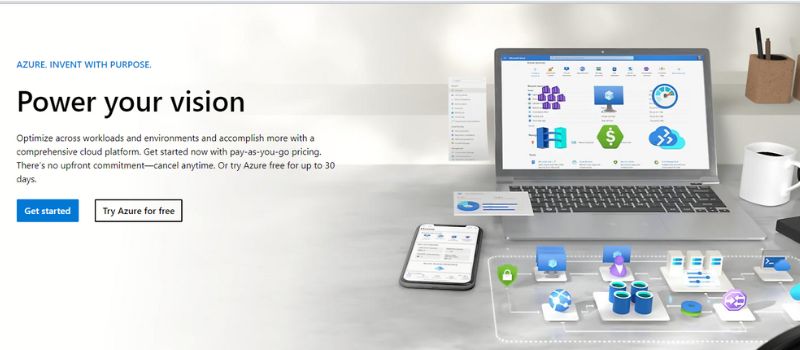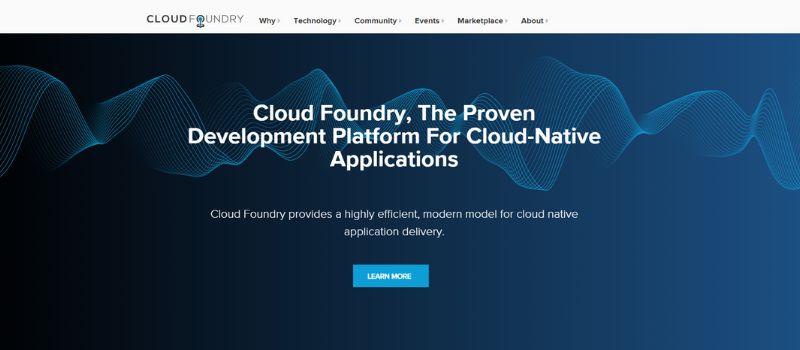Uncategorized
Top 10 PaaS Vendors for Cloud Computing

PaaS benefits developers who want to manage application hosting and simplify app deployment. However, not all PaaS tools offer the same features.
The PaaS that provides users with a platform to develop, run, and manage web applications without the burden of building and maintaining the infrastructure. PaaS providers typically offer a range of tools and services, including web servers, databases, and programming languages, that make it easy for developers to create, test, and deploy their applications. Building and deploying web and mobile applications. In addition, it helps improve data processing and analysis.
Here are the top 10 PaaS vendors to help you choose the most cost-effective solutions for your business.
1. Amazon Web Services (AWS)
Amazon Web Services is a comprehensive cloud platform that offers a wide range of services. Below are the PaaS offerings of AWS.
- Elastic Beanstalk
- App Runner
- Lambda
- API Gateway
- Elastic Container Registry (ECR)
- AppSync
- CodeStar
- AWS CodeBuild
2. Microsoft Azure

Microsoft Azure is a popular cloud platform that offers a variety of PaaS services, including Azure App Service, Azure Functions, and Azure Kubernetes Service. Check out the complete list of Microsoft Azure PaaS products below:
- Azure App Service
- Azure Functions
- Azure Kubernetes Service (AKS)
- Azure Service Fabric
- Azure Database for PostgreSQL, MySQL, SQL Server, Cosmos DB
- Azure Event Grid
- Azure Logic Apps
- Azure Container Instances
- Azure Batch
- Azure DevOps
However, the list might change and update over time as Microsoft Azure continues adding new features and editing existing ones.
3. Google Cloud Platform (GCP)
Google Cloud Platform (GCP) is a collection of cloud computing services offered by Google that includes a wide range of Platform-as-a-Service (PaaS) products and services. Some examples of Google Cloud PaaS products include:
- App Engine
- Cloud FunctionsCloud Run
- Cloud SQL, Cloud Spanner, Cloud Firestore, Bigtable
4. Heroku
Heroku is a popular PaaS vendor that provides a platform for building, deploying, and scaling web and mobile apps. Here are some examples of Heroku PaaS products:
- Heroku Platform
- Heroku Postgres
- Heroku Connect
- Heroku Private Spaces
- Heroku Shield
Please note that Heroku is a Salesforce company, and its products may change over time, and new ones may be added.
5. Pivotal Cloud Foundry

The next vendor is an open-source PaaS platform that supports multiple languages and frameworks. Some examples of Pivotal Cloud Foundry PaaS products:
- Pivotal Application Service (PAS)
- Pivotal Container Service (PKS)
- Pivotal Cloud Cache
- Pivotal Event Streams
- Pivotal Platform Dev
6. Red Hat OpenShift
If you’re looking for an open-source PaaS platform, Red Hat OpenShift is another option. It is built on top of Kubernetes which offers support for multiple languages and frameworks.
Below are the key Red Hat OpenShift Platform-as-a-Service (PaaS) products:
- OpenShift Container Platform
- OpenShift Online
- OpenShift Dedicated
- OpenShift Virtualization
- OpenShift Service Mesh
- OpenShift Pipelines
7. SAP Cloud Platform
SAP Cloud Platform supports multiple programming languages and provides various services for building and deploying enterprise-grade applications. Here are few of the SAP Cloud Platform PaaS products:
- SAP Cloud Platform
- SAP Cloud Platform Business RulesSA
- SAP systems and non-SAP systems
- SAP Cloud Platform Extension Factory
- SAP Cloud Platform Workflow
- SAP Cloud Platform Portal
- SAP Cloud Platform Big Data Services
8. Salesforce Lightning Platform

Salesforce Lightning Platform allows developers to build custom apps in addition to the Salesforce CRM system. Here are some examples of Salesforce Lightning Platform PaaS products:
- Salesforce Lightning Platform
- Salesforce Lightning App BuilderSales
- force Lightning Flow
- Salesforce Lightning Process Builder
- Salesforce Lightning Connect
9. Oracle Cloud Platform
Oracle Cloud Platform is a cloud-based Platform-as-a-Service (PaaS) provider that allows businesses to build, deploy, and scale their applications on top of the Oracle ecosystem. Here is a list of some of the essential Oracle Cloud Platform PaaS products:
- Oracle Cloud Infrastructure
- Oracle Cloud Infrastructure Container Engine for Kubernetes
- Oracle Cloud Infrastructure Functions
- Oracle Cloud Infrastructure Streaming
- Oracle Cloud Infrastructure Developer Services
- Oracle Cloud Infrastructure Data Flow
10. OpenFaaS
OpenFaaS is a platform that easily turn anything into a serverless function that runs on Linux or windows through Docker or Kubernetes.
- OpenFaaS CLI (Command Line Interface
- OpenFaaS Gateway
- OpenFaaS Watchdog
- OpenFaaS Template Store
- OpenFaaS Function Store
- OpenFaaS Portal
- OpenFaaS Cloud
- OpenFaaS Kubernetes Operator
- OpenFaaS Helm Chart
Conclusion
PaaS vendors generally develop products geared toward software development. These products provide users with resources such as computing power and data storage capacity on demand. Plus, bother functions like version management, text editing, testing services, and more. The choice is all yours depending on the need of your business or organization.

Uncategorized
Leveraging LinkedIn Careers for Professional Success

In today’s dynamic and competitive job market, having a strong professional presence online is crucial for career advancement. Fortunately, there are plenty of web applications and platforms that you can you for personal and business purposes. Among various platforms, LinkedIn stands out as the go-to destination for professionals to network, showcase their skills, and explore new job opportunities. With over 700 million users worldwide, LinkedIn offers a plethora of resources and tools designed to help individuals achieve their career goals. In this article, we will delve into the power of LinkedIn Careers and explore how you can leverage its potential to propel your professional success.
Creating an Impressive Profile

Your LinkedIn profile serves as your virtual resume and the first impression for potential employers and business connections. To make it stand out, ensure you have a professional photo, a compelling headline, and a well-crafted summary that showcases your expertise and career aspirations. Utilize relevant keywords to optimize your profile for search results and attract recruiters or employers looking for candidates with your skill set.
Joining and Participating in Groups
LinkedIn groups are a treasure trove of knowledge and networking opportunities. Find and join groups relevant to your profession or interests, and actively participate in discussions. Engaging in group conversations allows you to showcase your expertise, learn from others, and expand your network. Additionally, groups often post job openings or share industry-specific news, making them an invaluable resource for career growth.
Building a Strong Network

LinkedIn is all about networking, and the more connections you have, the wider your reach in the professional world. Connect with colleagues, classmates, industry peers, and even individuals from other sectors who share similar interests. Engage with your connections by congratulating them on their achievements, endorsing their skills, or sharing valuable content. Building a robust network opens doors to potential job opportunities, collaborations, and industry insights.
Showcasing Your Work and Accomplishments
The “Featured” section on LinkedIn allows you to showcase your best work, such as articles, presentations, projects, or even awards. Demonstrating your accomplishments not only adds credibility to your profile but also provides a glimpse of your capabilities to potential employers. Share valuable content regularly to establish yourself as a thought leader in your industry.
Seeking Recommendations and Endorsements
Having recommendations from colleagues, supervisors, or clients adds significant weight to your profile. Reach out to people you have worked with closely and request recommendations that highlight your skills and achievements. Additionally, endorse your connections’ skills, and they are likely to reciprocate, enhancing the credibility of your profile.
Learning with LinkedIn Learning

LinkedIn Learning offers a vast library of courses on various subjects, from technical skills to leadership development. Upskilling and continuous learning are essential for career growth, and LinkedIn Learning provides a convenient platform to acquire new knowledge and improve existing skills.
Utilizing the Job Search and Filters
LinkedIn’s job search feature is a powerful tool for finding new opportunities. You can filter job listings based on location, experience level, industry, and more. Save your job searches and enable notifications to stay updated on relevant openings. Tailor your application and resume to each position, and if possible, try to connect with employees from the hiring company to gain insights and improve your chances.
Engaging with Company Pages

Follow the company pages of your target employers to stay informed about their updates, news, and job openings. Engaging with their content, such as liking, sharing, or commenting, increases your visibility within the company’s network. This engagement may even catch the attention of recruiters, increasing the likelihood of being considered for future roles.
Utilizing the Alumni Tool
The LinkedIn Alumni Tool allows you to connect with graduates from your alma mater who are working in your desired field or company. These connections can provide valuable insights into job opportunities, company culture, and industry trends.
Engaging with Content and Creating Your Own
LinkedIn is a content-rich platform with articles, posts, and videos covering various topics. Engage with content that resonates with you and share your thoughts through comments or re-shares. Additionally, consider creating your own content to share your perspectives, expertise, and experiences. This not only helps in building your personal brand but also fosters meaningful conversations within your network.
Conclusion
LinkedIn Careers offers an abundance of opportunities to advance your professional journey. By creating a compelling profile, expanding your network, engaging with relevant content, and utilizing the platform’s tools, you can harness the full potential of LinkedIn to propel your career forward. Stay proactive, continue learning, and leverage the power of networking to unlock exciting possibilities on LinkedIn.
Marketing & Advertising
8 Popular Communication Tools for 2023

Communication tools have become an essential part of our daily lives. Thanks to technological advancement, we now have access to various devices that allow us to communicate with anyone, anywhere in the world. Check out the most popular communication tools individuals and businesses use today.
1. Email

Email is the most useful communication tool today. It lets us send messages to anyone with an email address anywhere. Email is very efficient because it lets us send messages quickly and easily. It also allows us to attach files and documents to our emails, making it easy to share information.
2. Instant Messaging
Instant messaging (IM) is another popular communication tool. It allows us to send real-time messages to anyone with an internet connection. IM is often used for casual conversations between friends and family members. However, it is also used in business settings for quick communication between coworkers.
3. Video Conferencing
Video conferencing has become increasingly popular in recent years. It allows us to have face-to-face conversations with people in different locations. Video conferencing is often used in business settings for meetings and presentations. It also serves as a personal communication tool between family members and friends who live far apart.
4. Social Media

Social media has become a popular communication tool in recent years. It allows us to connect with people worldwide and share information, photos, and videos. Social media is often used for personal communication between friends and family members. However, it is also suitable for business for marketing and customer service.
5. Voice over Internet Protocol (VoIP)
Voice over Internet Protocol (VoIP) allows us to make phone calls over the internet. VoIP is a cost-effective alternative to traditional phone systems. It will enable us to make international calls at a more affordable cost compared with traditional phone systems.
6. Project Management Tools
Project management tools help manage tasks and projects in a collaborative setting. These tools allow teams to communicate and
collaborate on projects in real-time. Project management tools are used in business settings for project management and collaboration.
7. Email Marketing Tools
Email marketing tools are used to send promotional emails to customers and subscribers. These tools allow businesses to create and send emails to large groups of people at once. Email marketing tools are often used for marketing and customer engagement in business settings.
8. Chatbots
Chatbots are automated chat systems that can answer questions and assist customers. AI chatbots are often used in customer service by providing quick and efficient support to customers.
Conclusion
Communication tools have become essential to our daily lives. They allow us to connect with people from all over the world and communicate quickly and efficiently. With so many communication tools available, choosing the right tool for our daily tasks is essential. Whether for personal or business communication, a communication tool is available that can help us get the job done.
Uncategorized
6 Applications of AI in Finance Services

AI has enabled financial institutions to process and analyze vast amounts of data in real-time. This has led to the development of innovative financial products and services, improved risk management, and increased efficiency in operations. AI is being used across various areas of finance, including investment management, trading, fraud detection, customer service, and regulatory compliance. As AI continues to develop, its role in the financial industry is expected to grow, bringing new opportunities and challenges for businesses and consumers. Check out the various applications of AI in finance.
1. Fraud Detection and Prevention

AI algorithms can analyze financial data and detect patterns that may indicate fraudulent activity. It can help prevent financial crimes by identifying potential risks early on. An example of AI in fraud detection is using machine learning algorithms to analyze credit card transactions and identify suspicious activity. If an AI system detects an unusual pattern of transactions, it can trigger an alert to the cardholder or issuer.
2. Customer Service
AI-powered chatbots can provide personalized customer service, answer queries, and help customers with financial advice. Many banks use chatbots to handle routine customer queries such as balance inquiries, transaction history, and payment schedules.
3. Risk Assessment
AI algorithms can assess risk more accurately than humans by analyzing large datasets and identifying patterns that may indicate potential hazards. Artificial intelligence can determine borrowers’ creditworthiness by examining their credit history, financial statements, and other relevant data. This can help lenders make more informed decisions about approving a loan.
4. Trading and Investment

AI algorithms can analyze market trends, news, and social media activity to make informed investment decisions. Hedge funds use AI algorithms to research news articles and social media activity to identify trends and predict market movements.
5. Robo-advisory
AI-powered robo-advisors can provide investment advice and portfolio management services to customers based on risk tolerance, investment goals, and other factors. Wealthfront and Betterment are two examples of robo-advisors that use AI to provide investment advice to customers.
6. Process Automation
AI can automate routine financial tasks such as account reconciliation, data entry, and reporting. AI-powered software can automatically reconcile bank statements and identify discrepancies, reducing the need for manual intervention.
Benefits of AI in Finance
There are numerous benefits of Artificial Intelligence (AI) in finance. Below are some of the most significant benefits in financial sector:
- Reducing errors
- Reducing repetitive manual tasks
- Reducing costs and increasing profitability for financial institutions
- Enhancing customer experience
- Improving risk management
- Detecting fraud and other financial crimes
- Improving decision-making
Conclusion
By leveraging AI, financial institutions can improve efficiency, reduce costs, increase accuracy, and make better-informed decisions. Likewise, AI can help to improve customer experiences by providing personalized services and enhancing the security of financial transactions. We can expect to see more innovative applications of AI in finance services in the future as advancements in AI tech unfolds.
-

 Cloud2 years ago
Cloud2 years ago9 Examples of Vertical SaaS Companies That Are Making An Impact
-

 Cloud3 years ago
Cloud3 years ago3 Tips for Choosing the Best Cloud Computing Software for Your Small Business
-

 Cloud3 years ago
Cloud3 years agoTop 10 Software as a Service (SaaS) Companies
-

 Cloud3 years ago
Cloud3 years agoThe 10 Popular IaaS Examples
-

 Management2 years ago
Management2 years agoThe Top 10 HR SaaS Companies Redefining HR in 2023
-

 Management2 years ago
Management2 years agoThe Expanding Landscape of Data Science Jobs
-

 Marketing & Advertising2 years ago
Marketing & Advertising2 years ago8 Popular Communication Tools for 2023
-

 Management2 years ago
Management2 years agoWhere to Hire Freelance SaaS Developers